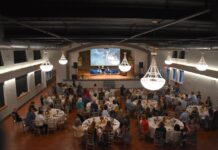by Tim Kenyon
IOWA – The Iowa Northern and Cedar Rapids and Iowa City Railway Co. (CRANDIC) rail lines are eager for better times after navigating through extended post-flood recovery projects. Iowa Northern Administration Director Joshua Sabin said business is moving upward.
“It’s getting much, much better,” Mr. Sabin said last week from his Cedar Rapids office. “We’re anxious to get back to pre-flood traffic consistently such as in 2007 when we had 1,200 grain cars monthly.”
If the trend over the first six weeks of 2010 holds up, it might hit near that as the first quarter ends, he said.
“We’re starting to have a significant rebound. The last year and a half was painful,” he said. “Post-flood 2008 and through 2009 we averaged just 800 (grain) cars monthly.”
Economic and weather conditions also created challenges in late fall and early winter, said Mr. Sabin, whose family owns Iowa Northern.
“It was a strange harvest season because of both the weather and economy,” he said. “It was late because of wet weather and even when it cleared off and farmers were able to get the harvest in from the fields there was slow response trafficwise as markets were not as active.”
Typically, much of the company’s business is transporting corn and soybeans from elevators starting as far north as Worth County and winding down through Waterloo and to Cedar Rapids.
It has a wide reach with direct connections to the Union Pacific, Canadian National, Canadian Pacific and CRANDIC. Those connections make it possible to reach the Burlington Northern Santa Fe, Kansas City Southern, CSXT, Norfolk Southern and Iowa Interstate lines.
Business at CRANDIC is nudging up, said Jeff Woods, a spokesman for the Alliant Energy-owned company.
“Our traffic is up slightly, in large part due to the return of flood-damaged industry and markets,” Mr. Woods said.
Iowa Interstate Railroad reported 2009 as a good year, because of diversification of products moved, Chief Operating Office Mick Burkhart said.
“We were very pleased,” Mr. Burkhart said. “We’re looking for an upbeat year again.”
Iowa Interstate runs basically from Chicago to Council Bluffs, including across tracks in Iowa City, Marengo and Homestead.
It transports agricultural products, ethanol, scrap metal and double-stacked containers for steamships.
“When one area turns down, the others keep us up. They don’t all downturn at the same time,” Mr. Burkhart said.
He hedged slightly when discussing prospects moving forward because of the rough time experienced nationally during the recent lengthy recession.
“I’m cautiously optimistic,” he said, echoing a line stated by several economists early this year.
Iowa Interstate sustained about $1 million damage to about a mile of tracks in the Moscow area because of the summer 2008 flooding, he noted.
Two bridges that required reconstruction caused havoc for 16 months and 13 months, respectively, for Iowa Northern and CRANDIC.
The disabled bridge over the Cedar River in Waterloo cut the Iowa Northern route in half.
On the north half, Iowa Northern hauled grain to Manly where it met the Union Pacific. The Union Pacific took the Iowa Northern traffic south to Nevada and then east to Cedar Rapids
Iowa Northern paid about half of the estimated $6 million to reconstruct the bridge, owned by Union Pacific.
CRANDIC’s nearly 800-foot bridge over the Cedar River just south of Eighth Avenue and leading to the Penford Products plant perhaps gained the most attention as rail cars drooped into the water at the end of the June 2008 flooding in Cedar Rapids.
It cost about $9 million to construct a new bridge in its place. CRANDIC sustained about $2 million additional damage elsewhere on its tracks around the Corridor.
Both Mr. Sabin and Mr. Woods will welcome completion of Archer Daniels Midland’s estimated $540 million dry grind mill later this year.
“ADM’s going to need more corn and we’ll play a role to help serve that need,” Mr. Sabin said.
ADM’s building of a second mill is priming the bright outlook for grain hauling at CRANDIC, Mr. Woods said.
Akin to other economic sectors in the Corridor, Mr. Woods said railroads are faring better than in other areas of the country.
Another factor is a movement to further regulate the industry, which makes big railroads nervous, he said.
“About six or seven railroads have the biggest influence and if you limit what they make with more regulations you limit what they can invest and that affects smaller lines, too,” he said.
Mr. Woods wants to see the Obama Administration follow through with more support toward rail freight business.
The administration’s passenger rail support benefits from great publicity, thus rail freight companies don’t want be overlooked as transportation improvements are planned.
“They (the administration) have certainly opened the door for grant monies and low-interest loans to be available for infrastructure improvements. Some are freight rail-industry specific and some are not,” Mr. Woods said. “We hope for more consideration as policies and plans are set.”
Mr. Sabin said rail infrastructure improvements to bridges susceptible to fast-rushing water and those that need width and height changes to safely transport wind-energy parts across are a few opportune areas the federal government could help.
The company is improving dispatching software as one example of emphasizing new technology, he said.
It also is researching ways to make locomotives more fuel efficient and improve tracking of car locations and weights, he added.
No new excursions are planned for the company’s Hawkeye Express. The train carries University of Iowa football fans from a spot just south of Coral Ridge Mall in Coralville to one just down the street from Kinnick Stadium in Iowa City. It ran one-time flood-relief events in Vinton and Palo.




